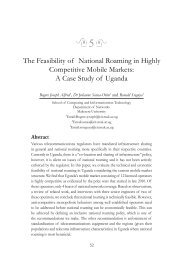Undergraduate Handbook - School of Computing and Informatics ...
Undergraduate Handbook - School of Computing and Informatics ...
Undergraduate Handbook - School of Computing and Informatics ...
You also want an ePaper? Increase the reach of your titles
YUMPU automatically turns print PDFs into web optimized ePapers that Google loves.
scoping<br />
• Type systems: strongly typed languages type checking (static vs. dynamic), type equivalence (by name vs.<br />
structural), overloading, coercion, polymorphism, type inference<br />
• Binding: declarations <strong>and</strong> environments. Block structure: scope <strong>and</strong> visibility, stack discipline. Bound<br />
occurrences: static vs. dynamic binding.<br />
• Encapsulation: information hiding, modules, abstract data types, classes<br />
• Language implementation: parsing, code generation, garbage collection.<br />
Reference Books:<br />
i. D. P. Friedman, M. W<strong>and</strong>, <strong>and</strong> C. T. Haynes, Essentials <strong>of</strong> Programming Languages, MIT Press, 2001<br />
BIS 3100: Modeling <strong>and</strong> Simulation (4 CU)<br />
Course Description: The course gives students theoretical <strong>and</strong> practical skills in modeling <strong>and</strong> simulation <strong>of</strong><br />
dynamic systems with a view <strong>of</strong> learning their behavior <strong>and</strong> the sensitivity <strong>of</strong> that behavior to certain parameters.<br />
The course will familiarize students with modeling <strong>and</strong> simulation techniques that are applicable under varying<br />
circumstances equip students with practical experiences <strong>of</strong> composing models <strong>and</strong> running simulations under<br />
varying circumstances, equip students with skills <strong>of</strong> correctly representing simulation results<br />
Indicative Content: Simulation <strong>of</strong> operational systems, Simulation as a decision making methodology, Model<br />
development <strong>and</strong> validation, Design <strong>of</strong> simulation experiments, Generation <strong>of</strong> appropriate values <strong>of</strong> r<strong>and</strong>om<br />
variables, Interactive procedures <strong>and</strong> interpretation <strong>of</strong> results.<br />
Reference Books:<br />
i. L. Oakshott, Business Modelling <strong>and</strong> Simulation, Trans- Atlantic Publications, 1997.<br />
ii. R. G. Coyle, System Dynamics Modeling a Practical Approach, Chapman & Hall/CRC, 1996.<br />
CSC 3105 Computer Graphics (3 CU)<br />
Course Description: The course covers general purpose graphics systems <strong>and</strong> their use. It gives an in-depth<br />
knowledge <strong>of</strong> computer graphics <strong>and</strong> graphical user interfaces.<br />
The course introduces students to the concepts <strong>of</strong> graphical representation on computers, teaches students the design<br />
<strong>of</strong> good graphical user interfaces.<br />
Indicative Content: Students are exposed to Graphics hardware, Geometrical transformations, Surface <strong>and</strong> volume<br />
visualization, Design <strong>and</strong> implementation <strong>of</strong> graphical user interfaces, Two dimensional imaging processes,<br />
Computer graphics applications, Display system organization; Display devices <strong>and</strong> modes; Display file construction<br />
<strong>and</strong> its structure; Graphic primitive - device initialization, view porting <strong>and</strong> windowing; Line drawing, simple <strong>and</strong><br />
symmetrical Digital Differential Analysis (DDA); Arch <strong>and</strong> circle generating DDA Line; <strong>and</strong> polygon clipping<br />
algorithms; Curve plotting; Transformations- projections <strong>and</strong> perspective views; Picture segmentation: Graphics<br />
st<strong>and</strong>ards - PHIGS <strong>and</strong> GKS.<br />
Reference Books:<br />
i. J. D. Foley, A. Van Dam, S. K. Feiner, J. F. Hughes <strong>and</strong> R. L. Phillips, Introduction to Computer<br />
Graphics, Addison Wesley, 2003.<br />
ii. P. Shirley, Fundamentals <strong>of</strong> Computer Graphics, AK Peters, 2002.<br />
CSC 3115 Advanced Programming (3 CU)<br />
Course Description: This course highlights programming practices that are vital in the day today work <strong>of</strong> a<br />
programming pr<strong>of</strong>essional. While many systems are described by functionalities, some important aspects like<br />
security, robustness, <strong>and</strong> maintainability are ignored. Students are to get an in-depth underst<strong>and</strong>ing <strong>of</strong> these concepts<br />
as well as exploring the current trends in the programming environment. This course will concretize the student’s<br />
past programming experience as well as highlighting critical practices in programming that are necessary for a<br />
50

















